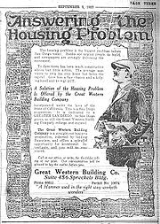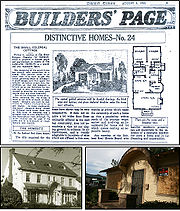
Better Homes in America Movement
Encyclopedia

Owner-occupier
An owner-occupier is a person who lives in and owns the same home. It is a type of housing tenure. The home of the owner-occupier may be, for example, a house, apartment, condominium, or a housing cooperative...
, modernization
Modernization
In the social sciences, modernization or modernisation refers to a model of an evolutionary transition from a 'pre-modern' or 'traditional' to a 'modern' society. The teleology of modernization is described in social evolutionism theories, existing as a template that has been generally followed by...
, and beautification
Beautification
Beautification is the process of making visual improvements to a person, place or thing. With regard to a town, city or to an urban area, this most often involves planting trees, shrubbery, and other greenery, but frequently also includes adding decorative or historic-style street lights and other...
because of a critical shortage of homes in the years right after World War I
World War I
World War I , which was predominantly called the World War or the Great War from its occurrence until 1939, and the First World War or World War I thereafter, was a major war centred in Europe that began on 28 July 1914 and lasted until 11 November 1918...
. This was the Better Homes Movement, which was initiated in the pages of the Butterick Publishing Company
Butterick Publishing Company
The Butterick Publishing Company was founded by Ebenezer Butterick to distribute the first graded sewing patterns. By 1867, it had released its first magazine, Ladies Quarterly of Broadway Fashions, followed by The Metropolitan in 1868. These magazines contained patterns and fashion news.In 1873,...
's household magazine, The Delineator
The Delineator
The Delineator was an American women's magazine of the late 19th and early 20th centuries, founded by the Butterick Publishing Company in 1869 under the name The Metropolitan Monthly. Its name was changed in 1875. In November 1926, under the editorship of Mrs...
, under the editorship of Marie Mattingly Meloney
Marie Mattingly Meloney
Marie Mattingly Meloney , who used Mrs. William B. Meloney as her professional and social name, was "one of the leading woman journalists of the United States," a magazine editor and a socialite who in the 1920s organized a fund drive to buy radium for Marie Curie and began a movement for better...
. The campaign celebrated home ownership, home maintenance and improvement, and home decoration as means of motivating responsible consumer behavior; it also expanded the market for consumer products
Product (business)
In general, the product is defined as a "thing produced by labor or effort" or the "result of an act or a process", and stems from the verb produce, from the Latin prōdūce ' lead or bring forth'. Since 1575, the word "product" has referred to anything produced...
. Annual local campaigns — or "better homes demonstration weeks" — encouraged people to own, build, remodel, and improve their homes and distributed advice on creating home furnishings and decorations.
President Warren G. Harding
Warren G. Harding
Warren Gamaliel Harding was the 29th President of the United States . A Republican from Ohio, Harding was an influential self-made newspaper publisher. He served in the Ohio Senate , as the 28th Lieutenant Governor of Ohio and as a U.S. Senator...
and Secretary of Commerce
United States Secretary of Commerce
The United States Secretary of Commerce is the head of the United States Department of Commerce concerned with business and industry; the Department states its mission to be "to foster, promote, and develop the foreign and domestic commerce"...
Herbert Hoover
Herbert Hoover
Herbert Clark Hoover was the 31st President of the United States . Hoover was originally a professional mining engineer and author. As the United States Secretary of Commerce in the 1920s under Presidents Warren Harding and Calvin Coolidge, he promoted partnerships between government and business...
kicked off the first Better Homes Week in October 1922 for the National Better Homes Advisory Council. The campaign centered on the 100th anniversary of John Howard Payne
John Howard Payne
John Howard Payne was an American actor, poet, playwright, and author who had most of his theatrical career and success in London. He is today most remembered as the creator of "Home! Sweet Home!", a song he wrote in 1822 that became widely popular in the United States, Great Britain, and the...
’s song Home! Sweet Home!
Home! Sweet Home!
"Home! Sweet Home!" is a song that has remained well-known for over 150 years. Adapted from American actor and dramatist John Howard Payne's 1823 opera Clari, Maid of Milan, the song's melody was composed by Englishman Sir Henry Bishop with lyrics by Payne...
. The Better Homes Movement received broad support from both government and industry. Vice-President Calvin Coolidge
Calvin Coolidge
John Calvin Coolidge, Jr. was the 30th President of the United States . A Republican lawyer from Vermont, Coolidge worked his way up the ladder of Massachusetts state politics, eventually becoming governor of that state...
served as honorary chairman of the Advisory Council of Better Homes in America, and Secretary of Commerce Herbert Hoover was president of its board of directors.
To commemorate the Better Homes Movement, a replica
Replica
A replica is a copy closely resembling the original concerning its shape and appearance. An inverted replica complements the original by filling its gaps. It can be a copy used for historical purposes, such as being placed in a museum. Sometimes the original never existed. For example, Difference...
of Payne’s colonial home in Long Island, New York, was built on the White House
White House
The White House is the official residence and principal workplace of the president of the United States. Located at 1600 Pennsylvania Avenue NW in Washington, D.C., the house was designed by Irish-born James Hoban, and built between 1792 and 1800 of white-painted Aquia sandstone in the Neoclassical...
lawn in Washington, D.C.
Washington, D.C.
Washington, D.C., formally the District of Columbia and commonly referred to as Washington, "the District", or simply D.C., is the capital of the United States. On July 16, 1790, the United States Congress approved the creation of a permanent national capital as permitted by the U.S. Constitution....
More than a million people visited the Payne House, and newspapers across America promoted other small Colonial Revival cottages like it.
Because of the patriotic and national sentiment of these years so soon after World War I, many of the model homes exhibited various Colonial Revival architectural
Colonial Revival architecture
The Colonial Revival was a nationalistic architectural style, garden design, and interior design movement in the United States which sought to revive elements of Georgian architecture, part of a broader Colonial Revival Movement in the arts. In the early 1890s Americans began to value their own...
elements. Newspapers often published designs of modest homes that were affordable
Affordable housing
Affordable housing is a term used to describe dwelling units whose total housing costs are deemed "affordable" to those that have a median income. Although the term is often applied to rental housing that is within the financial means of those in the lower income ranges of a geographical area, the...
and attractive to encourage new home construction under the Better Homes program.


